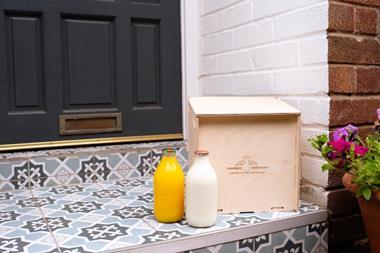There’s not much to suggest that Waitrose’s store in Temple Fortune, north London, is much different than its other stores. It is, however, the oldest continuously operated supermarket run by the grocer, having opened in 1945.
The timing of its reopening after six weeks refurbishment is also significant. It came earlier this week, just days before owner JLP announced plans today to build a pipeline of what would be the first new Waitrose supermarkets for a decade.
The partnership is back in profit after two years of consecutive losses and lost market share, and now that its cost-cutting measures are making progress, JLP wants to double down on what CEO Nish Kankiwala said was an “unashamed focus on retail”.
As well as a £542m investment this year in stores, automation and customer service, the partnership has also watered down its plans for buy-to-let housing as part of the rejigged strategy – now having no specific target for the amount of profits it makes from outside retail, instead of the previous aim of 40% by 2030.
There’s a reason too that JLP is doubling down on Waitrose, which in truth has long been the engine of the wider partnership. Nearly all the partnership’s one million additional customers came through Waitrose stores. Sales at the grocer grew 5%, in contrast to a 4% drop at John Lewis stores.
When asked what he felt was driving Waitrose’s improved performance, executive director James Bailey put it simply. “Just doing the retailer basics well and better and better,” had got customers spending more.
Focusing on retail is JLP’s prime strategy
“We’ve also just been delivering on the promise much more consistently,” Bailey told The Grocer, adding that Waitrose’s investment to bring down prices over the past year had also “stimulated growth”.
Put simply, Waitrose has focused on retail again.
Much of the work had gone on “behind the scenes” Bailey said. Hours have been rejigged, while investments have been made in tech, such as headsets that enable partners to easily raise queries with colleagues around the store – giving them more time in front of customers. Other investments, like higher shelving in stores, enables more products to be kept on the shop floor.
Troublesome work to upgrade to Waitrose’s ordering system – which caused sporadic periods of availability struggles in 2022 and early 2023 – is nearly complete after four years. At the same time, JLP has been investing in automation and simplifying processes within supply chain.
The result has been “record” availability over the second half of the year, Bailey said. He pointed to Waitrose’s performance in the Grocer 33 over the past year, in which it has won 21 times for service.
“Having all the products on the shelf when the customers arrive, it sounds like an obvious thing, but it makes an exceptional difference if you’ve not been able to do that as consistently as you would want,” Bailey said
Waitrose to improve stores
As part of its new store rollout, Waitrose will modernise 80 of its existing stores, focusing on making them nice places to visit.
Temple Fortune gives an indication of what can be expected from Waitrose’s newly improved stores.
New, more efficient fridges have been fitted throughout, as has new lighting to brighten the store. And the wine department has been moved to a more central area of the shop, while the fresh produce has been touched up, with additions like free-standing bays. All fairly unglamorous stuff.
Uncertainty remains, notwithstanding over the wider leadership, with the search still ongoing as to who will replace chairman Sharon White when she steps down in 2025. It’s also yet to be seen whether JLP can make plans to cut up to 11,000 roles from the partnership chime with its new commitment to service.
“Simpler shops, cost of goods, automation and systems,” Bailey said, highlighting the next areas of focus. “We’re at the beginning of that process, nowhere near the end of it.”
Waitrose has started to show the way. Now it’s up to John Lewis to catch up.

























No comments yet